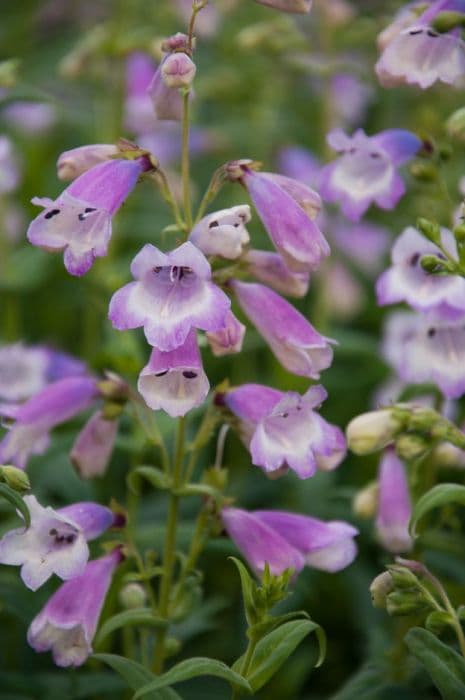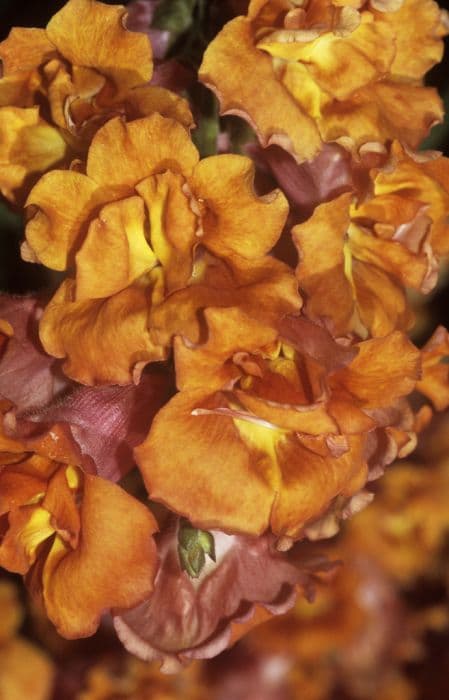Penstemon 'Pensham Great Expectations' Penstemon 'Pensham Great Expectations' (Pensham Series)

ABOUT
This selection bears flowers of violet and lilac with white throats. Height to 70cm
About this plant
 Names
NamesFamily
Plantaginaceae
Synonyms
Beardtongue
Common names
Penstemon 'Pensham Great Expectations' (Pensham Series).
 Characteristics
CharacteristicsLife cycle
Perennials
Foliage type
Semi-deciduous
Color of leaves
Green
Flower color
Purple
Height
2-3 feet (60-90 cm)
Spread
2-3 feet (60-90 cm)
Plant type
Herb
Hardiness zones
5
Native area
North America
Benefits
 General Benefits
General Benefits- Attracts Pollinators: The vibrant flowers of Penstemon, commonly known as Beard tongue, are known to attract bees, butterflies, and other beneficial pollinators to the garden.
- Drought Tolerant: Once established, Penstemon 'Pensham Great Expectations' has good drought tolerance, making it suitable for xeriscaping or low-water gardens.
- Long Blooming Period: Penstemon typically offers a long blooming season from late spring to early fall, providing extended color and interest in the garden.
- Easy to Grow: Beard tongue is generally an easy-to-care-for plant that doesn’t require a lot of maintenance, making it an excellent choice for gardeners of all levels.
- Low Maintenance: Penstemon plants are generally low-maintenance, requiring minimal pruning and deadheading to encourage new blooms.
- Versatile Garden Use: Beard tongue can be used in a variety of garden settings including borders, rock gardens, and as accent plants due to their upright habit and colorful flowers.
- Non-Invasive: Unlike some other perennials, Penstemon tends to stay where you plant it, without becoming invasive and overtaking garden spaces.
- Cold Hardy: Many Penstemon varieties, including those in the 'Pensham' Series, are hardy in a range of climates and can survive cold winter temperatures.
 Medical Properties
Medical PropertiesThis plant is not used for medical purposes.
 Air-purifying Qualities
Air-purifying QualitiesThis plant is not specifically known for air purifying qualities.
 Other Uses
Other Uses- Penstemon 'Pensham Great Expectations' can be used in floral photography due to its striking blooms, offering an excellent opportunity for gardeners and photographers to capture the intricate details of its flowers.
- This plant's stems can be used in creating botanical prints or nature-inspired art as they can leave detailed impressions on paper or fabric.
- Penstemon can be integrated into educational programs at schools or botanical gardens to teach about pollination, as it attracts a variety of pollinators including bees and hummingbirds.
- The long flowering period of this plant makes it a good candidate for observational studies on flowering patterns and their environmental triggers.
- Its vibrant flowers can serve as a natural dye source for small-scale fabric dying projects, providing a range of hues from its petals.
- Penstemon can be used as a natural border in gardens to create visual divisions between different outdoor 'rooms' or areas.
- These plants can play a role in sensory gardens, offering both visual appeal and a soft, textured foliage for tactile exploration.
- Penstemon blossoms can be used as adornments on cakes and other edible items, providing an organic, colorful touch to culinary presentations, making sure they are not treated with any harmful chemicals.
- In craft projects, the flowers and foliage can be pressed and preserved in glass frames to create lasting botanical artwork.
- Their structural stems and leaves can be used in garden-inspired sculptures and installations in collaboration with local artists or community projects.
Interesting Facts
 Feng Shui
Feng ShuiThe Beardtongue is not used in Feng Shui practice.
 Zodiac Sign Compitability
Zodiac Sign CompitabilityThe Beardtongue is not used in astrology practice.
 Plant Symbolism
Plant Symbolism- Endurance: Penstemons, including the 'Pensham Great Expectations,' are known for their hardy nature and ability to thrive in difficult conditions, symbolizing endurance and the ability to withstand challenges.
- Health: The vibrancy and robust nature of the plant is often associated with good health and vitality.
- Wealth: The lush and abundant flowers of the Penstemon can symbolize wealth and prosperity.
- Love: The vivid blooms may also represent the passion and excitement of love, much like the color and vibrancy of the flowers.
- Beauty: With its attractive blossoms, the Penstemon can signify beauty and appreciation for aesthetic pleasures.
 Water
WaterBeardtongue should be watered deeply but infrequently to mimic natural conditions and encourage deep root growth. Typically, watering once a week with about 1 to 1.5 gallons of water per plant is sufficient. During periods of drought or extreme heat, increase watering to twice a week. Ensure that the soil is well-draining to prevent root rot. Reduce watering in the cooler months to prevent overwatering.
 Light
LightBeardtongue thrives in full sun, meaning it should receive at least six to eight hours of direct sunlight each day. The best spot for planting beardtongue is in a location where it can enjoy uninterrupted sun throughout the day. However, in very hot climates, some afternoon shade can be beneficial to prevent scorching.
 Temperature
TemperatureThe ideal growing temperatures for Beardtongue are between 60 and 75 degrees Fahrenheit. It can survive minimum temperatures down to around 20 degrees Fahrenheit and maximum temperatures well into the 90s, as long as other conditions like watering and soil drainage are appropriate. It's important to protect the plant from frost and extremely high heat.
 Pruning
PruningBeardtongue should be pruned to remove spent flower spikes, which encourages a second blossoming and maintains a tidy appearance. Deadheading can be done throughout the blooming season as flowers fade. In late fall or early spring, prune back the entire plant to a few inches above the ground to promote vigorous new growth and prevent woody stems.
 Cleaning
CleaningAs needed
 Soil
SoilBeardtongue prefers well-draining soil enriched with organic matter, with an optimal pH range of 5.5 to 7.5 to flourish.
 Repotting
RepottingBeardtongue doesn't often require repotting as it is a perennial plant; repot only when it outgrows its current pot or every 2-3 years.
 Humidity & Misting
Humidity & MistingBeardtongue thrives in moderate humidity levels but is adaptable to different humidity conditions provided it is not extremely high.
 Suitable locations
Suitable locationsIndoor
Place in bright, indirect light with well-draining soil.
Outdoor
Full sun to part shade; shelter from strong winds.
Hardiness zone
4-9 USDA
 Life cycle
Life cyclePenstemon 'Pensham Great Expectations', commonly known as Beardtongue, begins its life as a seed, which when sown in early spring, germinates in warm, well-drained soil. After germination, the seedling develops a rosette of leaves at the soil surface, and as it matures, it forms a sturdy stem and a deep root system. During late spring to early summer, the plant enters its flowering stage, showcasing tubular flowers that attract pollinators such as bees and hummingbirds. After pollination, the flowers produce small capsules filled with seeds, marking the plant's reproductive phase. As the growing season ends, Beardtongue enters a period of dormancy, with the aerial parts dying back and the plant surviving as a perennial rootstock through the winter. The cycle restarts the following spring when new shoots emerge from the rootstock, leading to another season of growth and flowering.
 Propogation
PropogationPropogation time
Spring-Early Summer
The most popular method of propagating Penstemon 'Pensham Great Expectations' is through stem cuttings. The best time to take cuttings is in late spring or early summer when new growth is vigorous and healthy. To propagate, choose a non-flowering stem and cut a piece about 4-6 inches (approximately 10-15 cm) long, making the cut just below a node where leaves attach to the stem. Remove the leaves from the lower half of the cutting and dip the cut end into rooting hormone powder to encourage root development. Insert the cutting into a pot filled with a well-draining soil mix, ensuring that at least one node is below the surface where roots can form. Keep the soil moist but not waterlogged and place the pot in a warm place with indirect light until roots have formed, which typically takes a few weeks. Once rooted, the cuttings can be transplanted into individual pots or directly into the garden in the appropriate climate.









